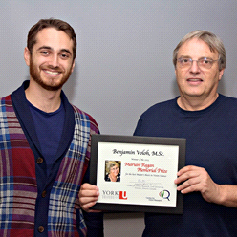The Centre for Vision Research at York University awarded the Marian Regan prize for the best master’s thesis in a vision-related topic submitted in 2015-16. The prize was awarded to Benjamin Voloh for his thesis on theta-gamma coupling in the frontal cortex. Voloh’s project was supervised by York Biology Professor Thilo Womelsdorf. The committee awarding the prize was chaired by Psychology Professor Fran Wilkinson. The prize was presented to Voloh on Oct. 14 by Professor Laurence Harris, the director of the Centre for Vision Research.

The prize is named for Professor Marian P. Regan (1937-2010), the wife of David Martin Regan, professor emeritus and a distinguished research professor at York University and a beloved member of the Centre for Vision Reserch.
Marian Regan was born in Folkstone in England and her family soon moved to London. During the war, she was evacuated to a farm in Wales with her brother and sister to escape the bombing in 1940-41 and again to escape the V1 and V2 rocket attacks at the end of the war. She read mathematics at London University, where she met her future husband in 1956. She then taught maths in a girl’s grammar school in London.

After moving to Newcastle-under-Lyme in 1965 (where her husband was employed at Keele University) she continued teaching mathematics. In 1975 she and her husband moved to Dalhousie University where she completed a master’s degree in mathematics while her two sons were at school. In 1986 they moved to York University where she developed a novel mathematical technique for modelling nonlinear systems, such as the human visual and auditory systems.
She was awarded a PhD under the supervision of the late Professor Ralph Nichols, who was then chair of physics, and went on to use her technique to model human steady-state electrical and magnetic brain responses to visual and auditory stimulation. She published papers in Vision Research, Auditory Research, Brain Research, Experimental Brain Research, Biological Cybernetics, and the Canadian Journal of Neuroscience. She died on April 17, 2010.


